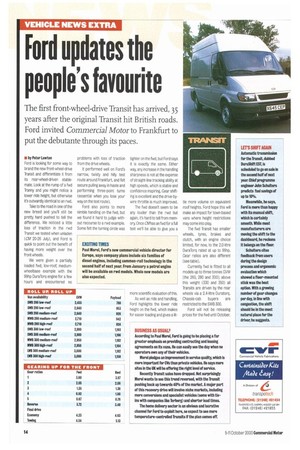Ford updates the people's favourite
Page 16

If you've noticed an error in this article please click here to report it so we can fix it.
The first front-wheel-drive Transit has arrived, 35 years after the original Transit hit British roads. Ford invited Commercial Motor to Frankfurt to put the debutante through its paces.
• by Peter Lawton Ford is looking for some way to brand the new front-wheel-drive Transit and differentiate it from its rear-wheel-driven stablemate. Look at the rump of a fwd Tranny and you might notice a lower ride height, but otherwise it's outwardly identical to an rwd, Take to the road in one of the new breed and you'll still be pretty hard pushed to tell the difference. We noticed a little loss of traction in the rwd Transit we tested when unladen (CM 20-26 July), and Ford is quick to point out the benefit of having more weight over the front wheels.
We were given a partially loaded fwd, low-root mediumwheelbase example with the 99hp DuraTorq engine for a few hours and encountered no problems with loss of traction from the drive wheels.
It performed well on Ford's narrow, twisty and hilly test route around Frankfurt, and felt secure pulling away in haste and performing three-point turns (essential when you lose your way on the test route).
Ford also points to more nimble handling on the fwd, but we found it hard to judge without recourse to a rwd example. Some felt the turning circle was tighter on the fwd, but Ford says it is exactly the same. Either way, any increase in the handling sharpness is not at the expense of straight-line tracking ability at high speeds, which is stable and confidence inspiring. Gear shifting is excellent and the drive-bywire throttle is much improved.
The fwd doesn't seem to be any louder than the rwd but again, it's hard to tell from memory. Once CMhas an fwd for a full test be able to give you a tle more volume on equivalent roof heights. Ford hope this will make an impact for town-based vans where height restrictions may come into play.
The fwd Transit has smaller wheels, tyres, brakes and clutch, with an engine choice limited, for now, to the 2.0-litre DuraTorq rated at up to 99hp. Gear ratios are also different (see table).
Currently fwd is fitted to all models up to three tonnes GVW (the 260, 280 and 300); above this weight (330 and 350) all Transits are driven by the rear wheels via a 2.4-litre Duratorq.
Chassis-cab buyers are restricted to the SWB 300,
Ford will not be releasing prices for the fwd until October.
















































































































